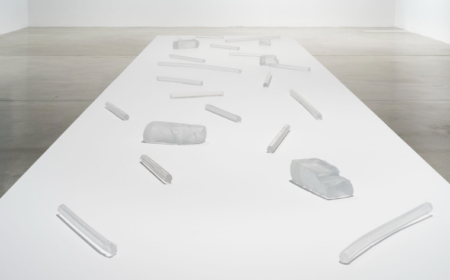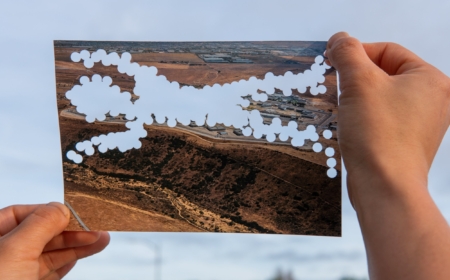By John Malkin
October 4, 2023
Interview with Chicago-based artist Maria Gaspar about her first West Coast solo exhibition Compositions at the UC Santa Cruz Institute of the Arts and Sciences (IAS) Gallery from September 26 to March 3, 2024. The opening celebration is Friday, October 6, 6 to 8 PM. An Artist Talk and Performance happens Saturday, October 7, 4 to 5:30 PM.
WE LIT THE FIRE AND TRUSTED THE HEAT:
Maria Gaspar Uses Jail Bars, Film and Sculpture to Challenge Prison Industrial Complex
Chicago-based artist Maria Gaspar grew up a few blocks from the Cook County Jail, the largest single-site jail in the United States. Gaspar uses visual art and sound to transform prisons and jails with the goal of creating a liberated world without incarceration. Her first West Coast solo exhibition Compositions is at the UC Santa Cruz Institute of the Arts and Sciences (IAS) Gallery at 100 Panetta Avenue from September 26 to March 3, 2024. The opening celebration is Friday, October 6, 6 to 8 PM. An Artist Talk and Performance happens Saturday, October 7, 4 to 5:30 PM when UCSC assistant professor of music James Gordon Williams will perform an improvised musical piece using iron jail bars from a section of Cook County Jail that was demolished.
ART AND ABOLITION
JM: Tell me about Compositions.
Maria Gaspar: Compositions includes glass casts of jail bars from Cook County Jail that I sourced. There’s video footage of a jail being dismantled that’s sixty hours long. There are photographs and works on paper where I hole-punched images of jails. I basically punched out jails and prisons in Illinois. There will be community workshops where people can come and punch out images of California prisons and jails.
JM: Where do you see your art within the larger abolition movement?
Maria Gaspar: I think about Ruth Wilson Gilmore, the Visualizing Abolition Project at the IAS, or Angela Davis and many others who’ve been working towards abolition for a very long time. I think about creativity and imagination. Art forms have historically been threatening to the status quo and it’s the first thing taken away in public schools. Art has this ability to radically transform who we are and how we interact with one another.
I think about abolition as a durational process with different speeds. At times you need an urgent response. And sometimes it takes time to give yourself space to unpack and negotiate relationships. So much of it is about being kind. All of those things are antithetical to how we are pressured to function in a capitalist society.
JM: How did growing up near the jail impact you?
Maria Gaspar: I think back to being a kid growing up on the west side of Chicago and seeing friends targeted by police. Many were also targeted to join the military. I’m first generation Mexican-American, so there’s a lot in my neighborhood we’ve experienced around immigrant detention, and we’re seeing that even more now. I visited the jail when I was twelve as part of a Scared Straight program. I had no idea what abolition was when I was that age! There was no conversation about what it meant to see people locked up in cages. I feel privileged to have the time to think through these ideas as an artist, but also as an educator and somebody who works in prisons.
EIGHTEEN IRON JAIL BARS
JM: I remember Scared Straight. The US government tried to frighten kids into being law-abiding citizens when at roughly the same time the government was selling drugs and weapons to fund illegal wars. You mentioned that you “sourced” the jail materials. How did that go?
Maria Gaspar: The demolition of a part of the jail was happening and I was filming the building coming down. I was meeting a lot of people. A judge came by and we talked. He was taking photographs of the demolition. He returned twenty minutes later and handed me a jail bar as a memento. Like, “Here’s a gift.” It was strange to get gifted a jail bar that has confined people and taken their lives away. I wondered, “Should I be holding this?” At a certain point I thought, “Let’s transform these bars.” I found out that the guards were informally collecting some of the bricks and bars. They were placing these at the entry of the demolition site. So, I walked over and said, “I’m an artist. Can I grab a couple?” I did this for a couple days and at a certain point there were no more materials. The demolition was still happening but I think there was this tension like, “What is she doing with these? She might be up to something.” I was able to collect twenty-three pieces of debris.
TRANSFORMATIVE SONIC SCULPTURES
JM: Tell me about the music in Compositions.
Maria Gaspar: I’ve brought eighteen iron jail bars for James Gordon Williams and other musicians to create improvised sonic sculptures. My new title for this is We Lit the Fire and Trusted the Heat, which is from the autobiography of Angela Davis. I think about what sounds and voices have been heard through those jail bars. And how music can help those materials be freed, sonically. It’s transformative.
Listen to this interview with Maria Gaspar at noon on Thursday, October 5, on “Transformation Highway” with John Malkin on KZSC 88.1 FM / kzsc.org.
To listen to the full interview, visit this link.
Image: Courtesy of the artist.




